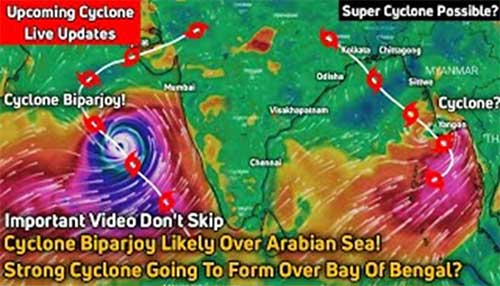Date : 19/06/2023
Relevance : GS Paper 1 : Geographical phenomena - Cyclone
Main Words : Advance Forecasting, Coastal-regulation-zone norms, Mangroves, and Wetland.
Context -
- Cyclone Biparjoy, a potent and highly destructive cyclonic storm, recently ravaged Gujarat and parts of Rajasthan.
- India successfully mitigated the impact of the disaster. While infrastructure damage, injuries, and livestock losses were evident, the casualties remained limited, showcasing the effectiveness of the IMD's early warning system.
What is Cyclone ?
- A cyclone is a large air mass that rotates around a strong center of low atmospheric pressure, counterclockwise in the Northern Hemisphere and clockwise in the Southern Hemisphere.
- Tropical cyclogenesis describes the process of development of tropical cyclones. Tropical cyclones form due to latent heat driven by significant thunderstorm activity, and are warm core. Cyclones can transition between extratropical, subtropical, and tropical phases.
- In the Atlantic and the northeastern Pacific oceans, a tropical cyclone is generally referred to as a hurricane, in the Indian and south Pacific oceans it is called a cyclone, and in the northwestern Pacific it is called a typhoon.
The Early Warnings:
- The IMD's proactive approach began on June 8, as they started disseminating reports regarding the cyclone's trajectory.
- IMD revised their initial estimates, signaling that the storm would no longer bypass India, but instead would make a sharp turn towards coastal Saurashtra in Gujarat.
- Classified as a "very severe" cyclone, with average wind speeds exceeding 115 kmph, the IMD's accurate forecast provided a crucial four-day lead time for necessary preparations.
Evacuation Measures and Preparedness:
- Utilizing the invaluable lead time, district authorities in Gujarat swiftly initiated evacuation efforts. Nearly 100,000 individuals residing in coastal regions were safely relocated to designated shelters.
- Additionally, approximately 30 central and State disaster relief teams were mobilized, ready to respond to any emergency situations.
- The railway services took proactive steps by canceling numerous trains, while fishermen were effectively warned to stay away from the treacherous sea.
Impact and Challenges:
- The aftermath of Cyclone Biparjoy resulted in power outages across 1,092 villages. Extensive damage was observed, with 5,120 electricity poles knocked down, along with approximately 186 transformers and 2,502 feeders damaged in the Saurashtra-Kutch region.
- Although some shops and establishments have resumed operations, a full return to normalcy remains an ongoing process.
Lessons Learned and Future Preparations:
- Experience from recent years has demonstrated that accurate predictions of cyclones and their potential impact are feasible within a 36-60 hour window.
- However, due to the nature of coastal infrastructure, inefficient communication networks, and unique livelihood patterns, precautionary measures face inherent limitations.
- Notably, the devastating cyclone that struck Gujarat in 1998 claimed the lives of nearly 3,000 individuals.
- While India has made significant progress since then, new threats loom, particularly the projected increase in severe cyclones originating from the Arabian Sea due to the effects of global warming.
- it is imperative to implement and strictly enforce coastal-regulation-zone norms, prescribing appropriate structures at specified distances from the shoreline. Strengthening the dwellings of rural coastal inhabitants and bolstering natural defenses like mangroves in wetlands are crucial steps to enhance resilience against future calamities.
Conclusion:
Through the timely and accurate warnings from the India Meteorological Department, India successfully averted a catastrophic outcome as Cyclone Biparjoy struck Gujarat. While some damage was unavoidable, the minimal loss of life underscores the importance of early preparedness and effective communication systems. As climate change continues to pose new challenges, a comprehensive approach that combines advanced forecasting, infrastructure improvements, and community resilience must be pursued to safeguard vulnerable coastal regions.
Probable Questions for mains exam-
- Question 1 : Discuss the significance of early warning systems in mitigating the impact of natural disasters, with a specific focus on cyclones. How did the India Meteorological Department's timely warnings help in managing the effects of Cyclone Biparjoy? (10 Marks)
- Question 2: Analyze the challenges faced by coastal regions in preparing for and responding to cyclones. Highlight the limitations of precautionary measures and the need for comprehensive strategies to enhance resilience in these areas.(15 Marks)
Source : The Hindu








